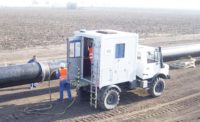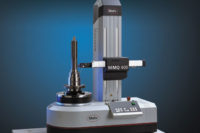The retightening torque measuring method is generally used to check the tightening condition of fasteners already in a product. But today's measuring method, though widely accepted, leaves room for error.
The desired torque value is loosely based on the torque at the moment the fastener retightens, but with the current method, this point is difficult to measure.
A new technique called the T-Point Retightening Torque Method measures the minimum value of retightening torque and helps eliminate the risk of human error. Before the benefits of the T-Point Retightening Torque Method are examined, an explanation of the current retightening torque method is necessary.
Current method
The current method requires that additional torque be applied using a dial or electronic wrench. This is done to determine the amount of torque needed for the fastener in the tightening direction. In general, fasteners have three torque points.
- A-point -- torque which overcomes static friction
- B-point -- torque at which the fastener retightens
- C-point -- maximum torque applied in this measurement.
The use of these methods depends on the accuracy required for the application.
Following are the characteristics of each torque point:
- A-point method. It is easy to measure, and the risk of human error is small. However, because the torque value is determined by static friction, this value is generally greater than the applied torque (Tt) and will be in some indirect relationship to the applied torque. Maximal value (A-point) by static friction does not exist in some fasteners.
- B-point method. A specialized technique is necessary to measure the point at which the lowest retightening torque is noted, especially because it is difficult to gage and therefore the accuracy of reading a correct value is low. This B-point value has been proven to be the closest value to the applied torque value, but a distinct minimum does not exist in some fasteners.
- C-point method. Measuring maximum torque is easy when using a torque wrench with a memory pointer feature. Because measurement values are determined by the operator, who must sense when the point is reached and release force from the torque wrench, the risk of human error is great. Generally, retightening torque is meant to be the C-point method. C-point may alternatively indicate A-point.
A closer look
Because the B-point method has been considered the best technique for gaging applied torque, it demands a closer look.
Though it is difficult to measure the B-point, this torque is basically equal to the applied torque in terms of continuity of the fastener tightening. However, because the applied torque is not always measured, as shown in Figure 2, there are some cases where the B-point is not difficult to gage (see Figures 2 to 4).
Torque applied to the fastener is divided into three kinds of torque:
T1 = Friction torque of bearing surface
T2 = Friction torque in the fastener thread
T3 = Torque converted to the fastener tension.
Since these three types of torque respectively change at the first stage, retightening torque becomes altered and more complicated.
This relationship is briefly examined:
1. Friction changes from static friction to dynamic friction.
2. Retightening torque is measured through spring action of the measuring instrument or socket.
3. The fastener head and thread move separately through the spring action of the fastener axis.
The movement, which becomes friction, changes the condition due to the combination of this friction and spring action, resulting in a complex change of the start torque when the fastener begins rotating.
The hardness of the two springs of the measuring instrument and the axis of the fastener also influence this change in torque. For example, torque is altered due to the length of the measuring instrument, socket and fastener.
To better explain this theory, circular motion is substituted for rectilinear motion in Figure 6. This illustration depicts a case in which the fastener head is retorqued. If the nut were retorqued, the illustration would appear differently. The theory, however, is the same. Since the actual fastener joint is a circular motion, this illustration does not show the real-time motion of the fastener. For example, load will change if the stroke and initial force are smaller than the friction force. It does, however, serve to explain the change in retightening torque.
In retorquing, force (F1) from the measuring instrument compresses the spring (k1). The spring moves the fastener head (W1), overcoming static friction and spring force (KW1 + F2). Next, the spring (k2) is compressed, and the force (F2) increases, finally moving the threaded part overcoming static friction (KW2). The threaded part then continuously moves in dynamic friction.
If the B-point is defined as torque when "threaded part" (W2) is retightened in dynamic friction, the more precise applied torque can be defined. However, during actual application of the retightening torque method, the operator cannot sense the rotation point of the threaded part. Instead, the operator can only sense the rotation of the "measuring instrument" or the "head part" as retightening torque. Specifically, this is not the retightening of the threaded part. If the torsion torque remains in the axis of the fastener as it has been tightened, the rotation of the fastener head will be linked to that of the threaded part.
Torsion torque relaxes in the axis of the fastener in some cases. In this case, first the head of the fastener rotates. The threaded part starts to rotate only after the torque increases in the axis up to the previously applied torque. The retightening torque of the bearing surface is lower than the previously applied torque.
As illustrated in Figure 6, if the external torque (F1) is removed, the head of the fastener receives the reaction force (F2), which is generated by the torsion in the axis of the fastener. Generally the bearing surface does not rotate in reverse from the action of the friction torque (uW1) of the bearing surface. But since the effective radius is small on hexagon socket head cap bolts and hexagon socket set bolts, the friction torque of the under head will become smaller by 50% (uW1 < uW2), and the head of the fastener will slightly rotate in reverse. In the case of the joint, which receives vibration, the head of the fastener is not loose.
Here, although the retightening torque of the head of the fastener is measured, the retightening point of the threaded part (B-point) cannot clearly be sensed and an estimation of the applied torque will be uncertain.
T-point: a new method
For estimating applied torque, the current B-point method is more effective than the A- or C-point methods. However, to precisely measure the minimum value of retightening torque and help eliminate the risk of human error, a new technique is recommended.
Even if an electronic technique is used to measure the exact torque, it is quite difficult to define the B-point from the change of torque applied to the head of the fastener during retightening rotation.
With the T-point method, when the change of retightening torque against the rotational angle of the measuring instrument is observed, retightening torque is applied -- first to the rotation of the head part and then to that of the threaded part -- shifted from static friction to dynamic friction. Friction whip phenomenon soon subsides, and the retightening torque line becomes a stable straight line. This line is basically an extension of the torque angle line when originally tightening the fastener.
In retightening torque, the unstable angle range (Du) during change of torque, is estimated by 10% of the torsion angle of the measuring instrument and axis of the fastener. The torsion angle of the measuring instrument is a maximum 6 degrees, even when a long socket is used, and the torsion of the fastener is about 2 degrees (see Figure 8), even when the fastener is 10 Arial longer than its diameter. Therefore, the unstable angle range is estimated within 1 degree. Even when experimentally measured, retightening torque will become stable within 1 degree.
Torque measured by an instrument is a nodal point of torsion angle line of measuring instrument and extended line of stable retightening torque line, which can be calculated from retightening torque within stable range, unstable angle and gradient of torque angle (dT/du). T-point torque (TT) is close to the applied torque. T-point torque is relatively stable; only a small measurement error -- approximately + or - 5% -- against the applied torque is possible. This method can easily be executed by an electronic technique using the measuring angle and torque and then calculated. Figure 9 shows the change of torque against angle during retightening torquing using a torque wrench.
This retightening torque method's use of data in the stable range almost eliminates human error compared to the conventional method. A digital torque wrench measures torque and angle and provides retightening torque (TT) that is close to the applied torque.
Measurement of applied torque
The T-point retightening torque method gives less dispersion compared to the conventional method. Furthermore, the central value almost corresponds to the applied torque.
Unlike the conventional retightening torque measuring technique, the new method does not need correction value by offset. Figure 10 shows the dispersion when the joint has no looseness and galling.
While the retightening torque method is generally used to check the tightening condition of fasteners already in a product, it also is used to calibrate nutrunners for a sampling inspection.
Traceability on tightening torque of nutrunners can be set up by this measurement of the T-point retightening torque method. But, if a great deal of relaxation takes place by vibration, even this retightening torque method will not accurately indicate the estimated value of the applied torque. To calibrate tightening torque of the nutrunners, retightening torque inspection should be executed under the same conditions as actual tightening -- just after the tightening job.
As is the case with the current retightening torque method, there are some situations where the T-point method cannot estimate the torque close to the applied torque. In the following instances, the difference should be measured and corrected in advance.
In cases in which the B-point torque is higher than the applied torque, which happens if the friction at the time of retightening torque inspection is larger than that at the time of original fastening of the fastener:
The lubrication of the fastener worsens in conjunction with the time passing after actual fastener tightening.
Galling occurs in the bearing surface or the threaded part after repeated use of the same fastener. The lubricant runs out or the friction surface has changed.
In cases in which the B-point torque is lower than the applied torque:
The tension of the fastener is reduced due to the tightening of a nearby fastener.
Creep occurs in the joint itself and results in a reduction in the fastener tension.
The fastener became loose by vibration or other means after tightening.
Retightening torque does not exactly mean previously applied torque, but the level of torque at which the fastener is being tightened during the time of measurement. If the retightening torque method is used for calibration of nutrunners, correction value should be taken into consideration.

